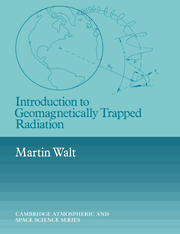Book contents
- Frontmatter
- Contents
- Preface
- List of symbols
- Useful constants
- Geophysical quantities
- Energy equivalents
- 1 The Earth's radiation belts
- 2 Charged particle motion in magnetic and electric fields
- 3 The geomagnetic field
- 4 Adiabatic invariants
- 5 Particle fluxes, distribution functions and radiation belt measurements
- 6 Particle diffusion and transport
- 7 Diffusion in pitch angle
- 8 Diffusion in the L coordinate or radial diffusion
- 9 Summary and comments
- Appendix A Summary of frequently used formulas
- Appendix B Gyration, bounce and drift frequencies in a dipole field
- References
- Index
1 - The Earth's radiation belts
Published online by Cambridge University Press: 21 September 2009
- Frontmatter
- Contents
- Preface
- List of symbols
- Useful constants
- Geophysical quantities
- Energy equivalents
- 1 The Earth's radiation belts
- 2 Charged particle motion in magnetic and electric fields
- 3 The geomagnetic field
- 4 Adiabatic invariants
- 5 Particle fluxes, distribution functions and radiation belt measurements
- 6 Particle diffusion and transport
- 7 Diffusion in pitch angle
- 8 Diffusion in the L coordinate or radial diffusion
- 9 Summary and comments
- Appendix A Summary of frequently used formulas
- Appendix B Gyration, bounce and drift frequencies in a dipole field
- References
- Index
Summary
Introduction
The discovery in 1958 that the Earth's magnetic field contains belts of energetic ions and electrons was a major milestone in geophysics and astronomy. This discovery can be viewed as the birth of magnetospheric physics since an enormous quantity of new knowledge concerning our planet's outer environment rapidly followed the first measurements of these radiation belts. Furthermore, the interpretation of many well-known phenomena, such as the aurora, magnetic storms and ionospheric structure, required major revisions in the light of this new information. Thus, our view of planet Earth was changed and enlarged by these new discoveries, nourished by the availability of space technology.
A thin upper atmosphere and ionosphere surrounded by an empty magnetic field were no longer seen as the outer envelope of the near-Earth region. Instead, the magnetic field was found to contain a population of ions and electrons of varied origin and having a rich, dynamic behavior. The geomagnetic field in the region between the ionosphere and the solar plasma accepts charged particles from both of these sources. The electric and magnetic fields accelerate, store and transport these particles, eventually returning them to the source regions. The complexity of the processes experienced by charged particles in the geomagnetic field is truly bewildering, such that, after 30 years of sustained effort, important phenomena are still only dimly perceived.
- Type
- Chapter
- Information
- Publisher: Cambridge University PressPrint publication year: 1994

